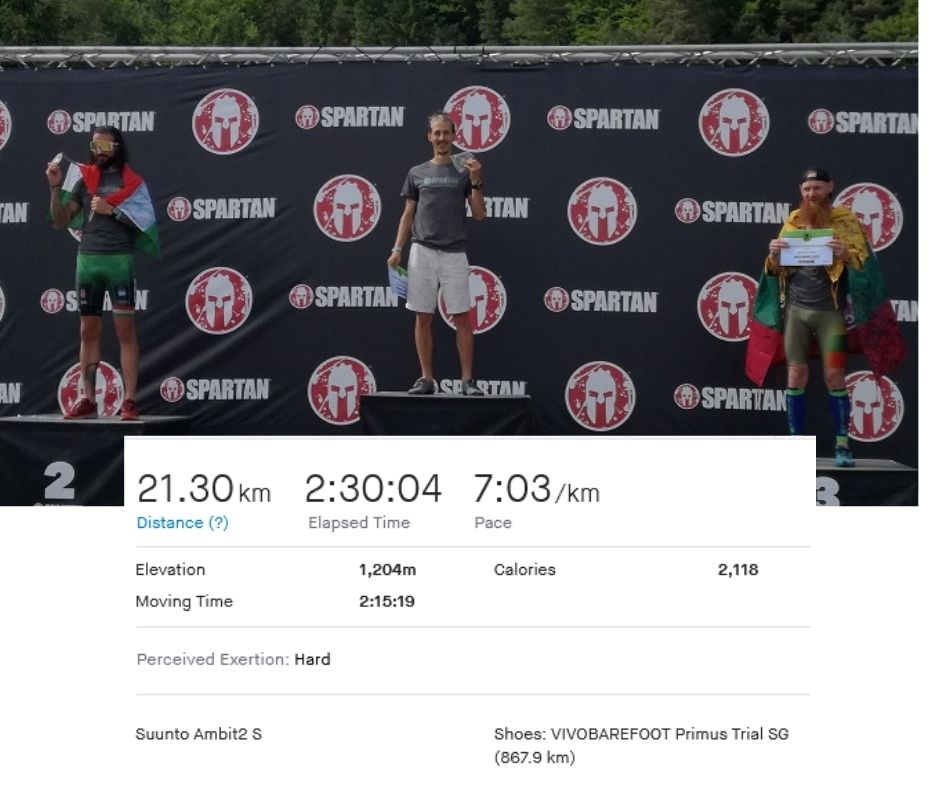Spartan Race Beast – Race Day Nutrition Example
What should I eat? When should I eat it? And what about hydration? These are just a few of many cocerns athletes face when deciding what to pack for a race so they feel their best.
Before we start, I have already covered topics related to race-day nutrition on my blog before. This one serves as a narrative example of what I did.
I placed 1st in the Age Group and 14th overall.
33°C, sunny weather
Check these posts:
- Race nutrition – all you need to know about how much and what forms of carbs to use during a race

Figuring out what and when to eat and drink during race is highly subjective. There I guidelines that athletes, coaches, nutritionists and elite athletes follow, but in the end, it needs to be personalized.
The day before the race:
The day before the race I did not change my eating at all. I have not increased carbohydrate intake nor made any changes to my diet. That is partially because I am already satisfied with my daily nutrition, which is a nice balance between tasty, healthy , and performance oriented.
I eat plenty of carbs from beans, grains including bread, and some fruit that is currently in season.
I get enough healthy fats in form of nuts, seeds, and some from soy products like tofu, tempeh and enriched soy milk.
My go to protein sources are legumes and tofu. Legumes are mainly a carbohydrate source, but they also contain about 20% protein, which is enough to cover my protein needs.
My macronutrient split is about 60% Carbs, 20% Fat, 20% Protein
Then I also eat a lot of vegetables that help me to stay hydrated. Vegetables are also full of vitamins and minerals, including electrolytes that are necessary for your body to stay healthy and work optimally.
I also don’t avoid table salt, which some health-conscious people avoid, for no reason. Sodium is an electrolyte that you need to keep hydrated and while whole foods contain electrolytes, you don’t need to be avoiding table salt.
Race-day:
I woke up at 5 a.m. and had my breakfast oatmeal at 6 a.m., 2h20m before my race. This is plenty of time to digest my breakfast of choice: oatmeal with chia seeds, carrot, handful of strawberries, 1/2 scoop of pea protein powder, cocoa powder and soy milk. I avoided adding additional nuts and seeds before the race, which can be problematic for digestion.
I eat oatmeal daily and I know how fast I can digest it.
About 30 minutes before the race I had an espresso, not for a performance enhancing effects of caffeine, but rather because I love coffee 🙂
For the race I packed about 150g soft dates, 4 energy gels (25g carbs each), and 0.5L of water dilluted apple joucie with a pinch of salt.
I knew hydration would be crucial because it was about 31°C and sunny this day.
Nutrition strategy during the race:
I will not lie. I did not feel strong when we started running. Maybe it was due to the lack of sleep but I just reminded myself of the training days that felt as hard, or even harder sometimes.
Knowing the race course is long and hilly (1200-1400m elevation gain depending on the source of information) I knew I had to start refueling soon into the race. Based on my experience, I like to start getting carbs in sooner on hilly course.
I stuck with having 1 gel – 25g carbs, every half an hour, which perfectly lined up with aid stations. That means I had a gel, grabbed a cup of water, drunk half of it and poured the rest on my back.
Because my hydration back torn just before the race, I had to stick with the aid stations. I did not feel thirtsy, but waiting to get thirsty is not a winning strategy! If I had water with me, I would proobably drink more regularly but in this case, I am not sure it would help. Hard to say.
Few notes on energy gels.
I bought energy gels just before the race. I tried them before but I had not been training and testing my stomach with these specific gels before. As a result I was gassy, but with no other noticeable ill-effects. Since gels are concentrated sugars, you want to ingest them together with water. Without water, energy gels take longer to digest and enter the blood stream.
The rate of ingestion of carbs during physical activity differs from person to person! That is why you need to test it ahead of your race.
If you like to make your own gels, here are two tried and tested, natural home-made gels for you:
After the race:
I started my post- race recovery by drinking water and a banana. About half an hour later, I ate oatmeal with chia seeds, and a scoop of protein powder, strawberries and mineral water.
After a race your body is drained. If you fuel properly, you will feel better and not so drained, though! That is why I keep saying that the recovery starts during the workout/race, not after it.
Anyway, after a race like Spartan Beast, you want to start refueling by getting in easy to digest carbs like rice, potatoes, sweet potatoes, pasta, and fruit. Couple that with a source of protein. I ommitted fats because I did not want to slow my digestion. I had an opportunity to include more fat for dinner.
One thing worth mentioning is also body weight.
Coming into the race I weighted 60kg. The morning after the race I weighted 56.5kg! The difference is in water and glycogen stores.
Being 3.5kg lighter (having 3.5kg less glyocogen and water combined) would not be ideal if I had to race two days in row!

